Enhanced Power Factor and Ultralow Lattice Thermal Conductivity Induced High Thermoelectric Performance of BiCuTeO/BiCuSeO Superlattice
Abstract
1. Introduction
2. Computational Methods
3. Results and Discussion
3.1. Crystal and Electronic Structures of BiMChO (M=Cu and Ag, Ch=S, Se and Te)
3.2. Transport Properties of BiMChO (M=Cu and Ag, Ch=S, Se and Te)
4. Conclusions
Supplementary Materials
Author Contributions
Funding
Institutional Review Board Statement
Informed Consent Statement
Data Availability Statement
Acknowledgments
Conflicts of Interest
References
- Yang, G.; Yang, J.; Yan, Y.; Wang, Y. The relationship between the electronic structure and thermoelectric properties of Zintl compounds M2Zn5As4 (M = K, Rb). Phys. Chem. Chem. Phys. 2014, 16, 5661–5666. [Google Scholar] [CrossRef] [PubMed]
- Ren, G.-K.; Wang, S.-Y.; Zhu, Y.-C.; Ventura, K.J.; Tan, X.; Xu, W.; Lin, Y.-H.; Yang, J.; Nan, C.-W. Enhancing thermoelectric performance in hierarchically structured BiCuSeO by increasing bond covalency and weakening carrier–phonon coupling. Energy Environ. Sci. 2017, 10, 1590–1599. [Google Scholar] [CrossRef]
- Shafique, A.; Shin, Y.-H. Thermoelectric and phonon transport properties of two-dimensional IV–VI compounds. Sci. Rep. 2017, 7, 506. [Google Scholar] [CrossRef] [PubMed]
- Liu, R.; Tan, X.; Liu, Y.-C.; Ren, G.-K.; Lan, J.-L.; Zhou, Z.-F.; Nan, C.-W.; Lin, Y.-H. BiCuSeO as state-of-the-art thermoelectric materials for energy conversion: From thin films to bulks. Rare Met. 2018, 37, 259–273. [Google Scholar] [CrossRef]
- Chen, K.X.; Lyu, S.S.; Wang, X.M.; Fu, Y.X.; Heng, Y.; Mo, D.C. Excellent Thermoelectric Performance Predicted in Two-Dimensional Buckled Antimonene: A First-Principles Study. J. Phys. Chem. C 2017, 121, 13035–13042. [Google Scholar] [CrossRef]
- Hohenberg, P.; Kohn, W. Inhomogeneous Electron Gas. Phys. Rev. 1964, 136, B864–B871. [Google Scholar] [CrossRef]
- Kozlovskiy, A.; Egizbek, K.; Zdorovets, M.V.; Ibragimova, M.; Shumskaya, A.; Rogachev, A.A.; Ignatovich, Z.V.; Kadyrzhanov, K. Evaluation of the Efficiency of Detection and Capture of Manganese in Aqueous Solutions of FeCeO(x) Nanocomposites Doped with Nb2O5. Sensors 2020, 20, 4851. [Google Scholar] [CrossRef]
- Trukhanov, S.V.; Kozlenko, D.P.; Trukhanov, A.V. High hydrostatic pressure effect on magnetic state of anion-deficient La0.70Sr0.30MnOx perovskite manganites. J. Magn. Magn. Mater. 2008, 320, e88–e91. [Google Scholar] [CrossRef]
- Zhao, L.-D.; He, J.; Berardan, D.; Lin, Y.; Li, J.-F.; Nan, C.-W.; Dragoe, N. BiCuSeO oxyselenides: New promising thermoelectric materials. Energy Environ. Sci. 2014, 7, 2900–2924. [Google Scholar] [CrossRef]
- Liu, Y.; Zhao, L.-D.; Liu, Y.; Lan, J.; Xu, W.; Li, F.; Zhang, B.-P.; Berardan, D.; Dragoe, N.; Lin, Y.-H.; et al. Remarkable enhancement in thermoelectric performance of BiCuSeO by Cu deficiencies. J. Am. Chem. Soc. 2011, 133, 20112–20115. [Google Scholar] [CrossRef]
- Kumar, S.; Schwingenschlögl, U. Lattice thermal conductivity in layered BiCuSeO. Phys. Chem. Chem. Phys. 2016, 18, 19158–19164. [Google Scholar] [CrossRef] [PubMed]
- Ren, G.-K.; Wang, S.; Zhou, Z.; Li, X.; Yang, J.; Zhang, W.; Lin, Y.-H.; Yang, J.; Nan, C.-W. Complex electronic structure and compositing effect in high performance thermoelectric BiCuSeO. Nat. Commun. 2019, 10, 2814. [Google Scholar] [CrossRef] [PubMed]
- Zdorovets, M.V.; Kozlovskiy, A.L.; Shlimas, D.I.; Borgekov, D.B. Phase transformations in FeCo–Fe2CoO4/Co3O4-spinel nanostructures as a result of thermal annealing and their practical application. J. Mater. Sci. Mater. Electron. 2021, 32, 16694–16705. [Google Scholar] [CrossRef]
- Turchenko, V.A.; Trukhanov, A.V.; Bobrikov, I.A.; Trukhanov, S.V.; Balagurov, A.M. Study of the crystalline and magnetic structures of BaFe11.4Al0.6O19 in a wide temperature range. J. Surf. Investig. X-ray Synchrotron Neutron Tech. 2015, 9, 17–23. [Google Scholar] [CrossRef]
- Pan, L.; Bérardan, D.; Zhao, L.; Barreteau, C.; Dragoe, N. Influence of Pb doping on the electrical transport properties of BiCuSeO. Appl. Phys. Lett. 2013, 102, 023902. [Google Scholar] [CrossRef]
- Wang, N.; Li, M.; Xiao, H.; Gao, Z.; Liu, Z.; Zu, X.; Li, S.; Qiao, L. Band degeneracy enhanced thermoelectric performance in layered oxyselenides by first-principles calculations. npj Comput. Mater. 2021, 7, 18. [Google Scholar] [CrossRef]
- Pan, L.; Lang, Y.; Zhao, L.; Berardan, D.; Amzallag, E.; Xu, C.; Gu, Y.; Chen, C.; Zhao, L.-D.; Shen, X.; et al. Realization of n-type and enhanced thermoelectric performance of p-type BiCuSeO by controlled iron incorporation. J. Mater. Chem. A 2018, 6, 13340–13349. [Google Scholar] [CrossRef]
- Broido, D.A.; Reinecke, T.L. Effect of superlattice structure on the thermoelectric figure of merit. Phys. Rev. B Condens. Matter. 1995, 51, 13797–13800. [Google Scholar] [CrossRef]
- Beyer, H.F.; Nurnus, J.; Böttner, H.; Lambrecht, A.; Roch, T.; Bauer, G. PbTe based superlattice structures with high thermoelectric efficiency. Appl. Phys. Lett. 2002, 80, 1216–1218. [Google Scholar] [CrossRef]
- Zhu, H.; Zhao, C.; Nan, P.; Jiang, X.-M.; Zhao, J.; Ge, B.; Xiao, C.; Xie, Y. Intrinsically Low Lattice Thermal Conductivity in Natural Superlattice (Bi2)m(Bi2Te3)n Thermoelectric Materials. Chem. Mater. 2021, 33, 1140–1148. [Google Scholar] [CrossRef]
- Biswas, R.K.; Pati, S.K. Exploring a Superlattice of SnO-PbO: A New Material for Thermoelectric Applications. ACS Appl. Energy Mater. 2021, 4, 2081–2090. [Google Scholar] [CrossRef]
- Köksal, O.; Pentcheva, R. Chern insulating phases and thermoelectric properties of EuO/MgO(001) superlattices. Phys. Rev. B 2021, 103, 045135. [Google Scholar] [CrossRef]
- Wang, J.; Cao, X.-H.; Zeng, Y.-J.; Luo, N.-N.; Tang, L.-M.; Chen, K.-Q. Excellent thermoelectric properties of monolayer MoS2-MoSe2 aperiodic superlattices. Appl. Surf. Sci. 2023, 612, 155914. [Google Scholar] [CrossRef]
- Touzelbaev, M.N.; Zhou, P.; Venkatasubramanian, R.; Goodson, K.E. Thermal characterization of Bi2Te3/Sb2Te3 superlattices. J. Appl. Phys. 2001, 90, 763–767. [Google Scholar] [CrossRef]
- Perdew, J.P.; Burke, K.; Ernzerhof, M. Generalized Gradient Approximation Made Simple. Phys. Rev. Lett. 1996, 77, 3865. [Google Scholar] [CrossRef]
- Blöchl, P.E. Projector augmented-wave method. Phys. Rev. B Condens. Matter. 1994, 50, 17953–17979. [Google Scholar] [CrossRef]
- Kohn, W.; Sham, L.J. Self-Consistent Equations Including Exchange and Correlation Effects. Phys. Rev. 1965, 140, A1133–A1138. [Google Scholar] [CrossRef]
- Kresse, G.; Joubert, D. From ultrasoft pseudopotentials to the projector augmented-wave method. Phys. Rev. Matter. 1999, 59, 1758. [Google Scholar] [CrossRef]
- Tran, F.; Blaha, P. Accurate band gaps of semiconductors and insulators with a semilocal exchange-correlation potential. Phys. Rev. Lett. 2009, 102, 226401. [Google Scholar] [CrossRef]
- Lin, C.; Cheng, W.; Chai, G.; Zhang, H. Thermoelectric properties of two-dimensional selenene and tellurene from group-VI elements. Phys. Chem. Chem. Phys. 2018, 20, 24250–24256. [Google Scholar] [CrossRef]
- Zhang, G.; Zhang, Y.-W. Thermoelectric properties of two-dimensional transition metal dichalcogenides. J. Mater. Chem. C 2017, 5, 7684–7698. [Google Scholar] [CrossRef]
- Madsen, G.K.; Singh, D.J. BoltzTraP. A code for calculating band-structure dependent quantities. Comput. Phys. Commun. 2006, 175, 67–71. [Google Scholar] [CrossRef]
- Liu, Y.; Lan, J.; Xu, W.; Liu, Y.; Pei, Y.-L.; Cheng, B.; Liu, D.-B.; Lin, Y.-H.; Zhao, L.-D. Enhanced thermoelectric performance of a BiCuSeO system via band gap tuning. Chem. Commun. 2013, 49, 8075–8077. [Google Scholar] [CrossRef]
- Zhang, S.; Xu, B.; Lin, Y.; Nan, C.; Liu, W. First-principles study of the layered thermoelectric material TiNBr. RSC Adv. 2019, 9, 12886–12894. [Google Scholar] [CrossRef] [PubMed]
- Zhao, L.-D.; Lo, S.-H.; Zhang, Y.; Sun, H.; Tan, G.; Uher, C.; Wolverton, C.; Dravid, V.P.; Kanatzidis, M.G. Ultralow thermal conductivity and high thermoelectric figure of merit in SnSe crystals. Nature 2014, 508, 373–377. [Google Scholar] [CrossRef]
- Wang, Q.; Han, L.; Wu, L.; Zhang, T.; Li, S.; Lu, P. Strain Effect on Thermoelectric Performance of InSe Monolayer. Nanoscale Res. Lett. 2019, 14, 287. [Google Scholar] [CrossRef] [PubMed]
- Li, W.; Carrete, J.; Katcho, N.A.; Mingo, N. ShengBTE: A solver of the Boltzmann transport equation for phonons. Comput. Phys. Commun. 2014, 185, 1747–1758. [Google Scholar] [CrossRef]
- Zhang, X.; Guo, Y.; Zhou, Z.; Li, Y.; Chen, Y.; Wang, J. A general strategy for designing two-dimensional high-efficiency layered thermoelectric materials. Energy Environ. Sci. 2021, 14, 4059–4066. [Google Scholar] [CrossRef]
- Bai, X.; Zhao, X.; Zhang, Y.; Ling, C.; Zhou, Y.; Wang, J.; Liu, Y. Dynamic Stability of Copper Single-Atom Catalysts under Working Conditions. J. Am. Chem. Soc. 2022, 144, 17140–17148. [Google Scholar] [CrossRef]
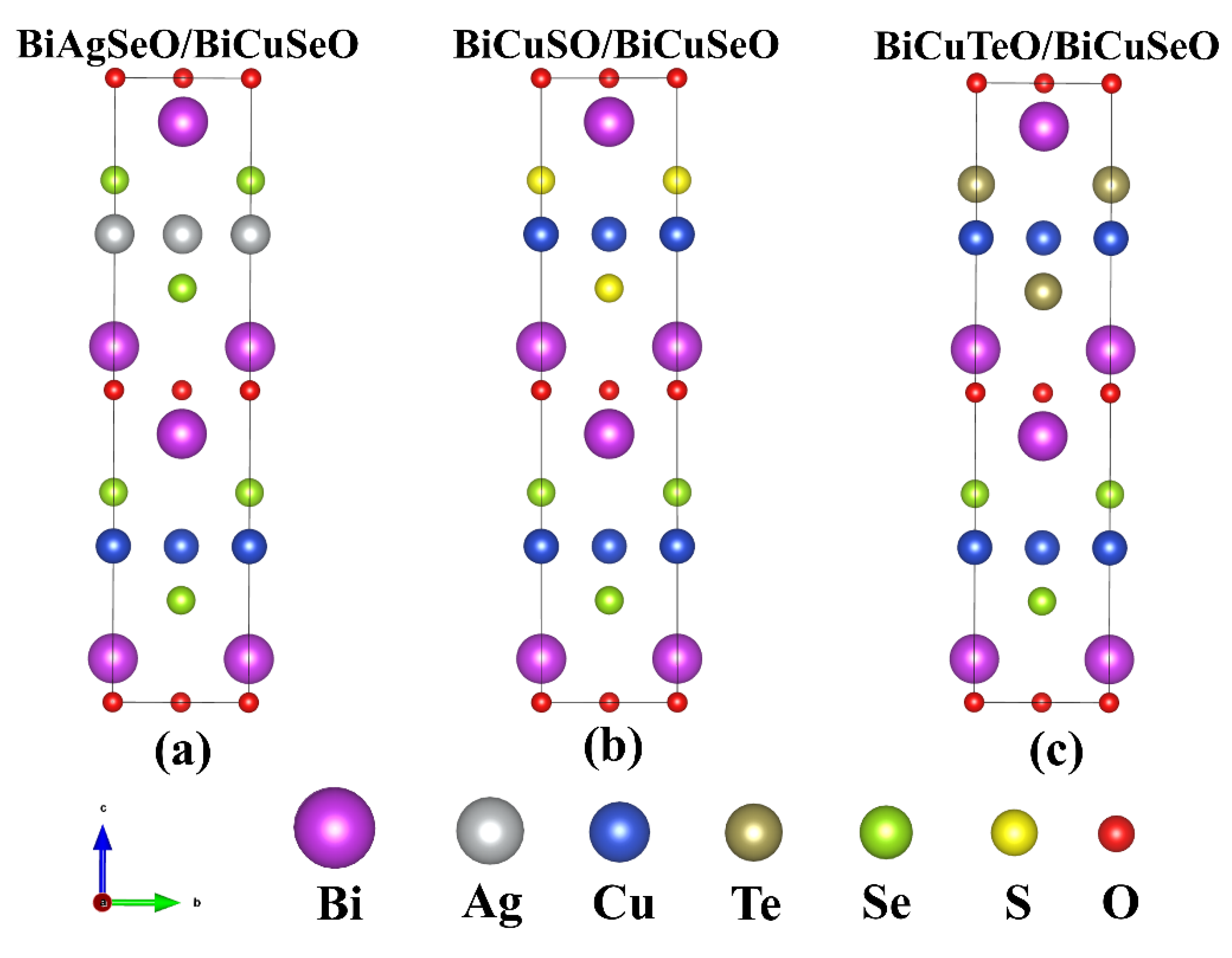
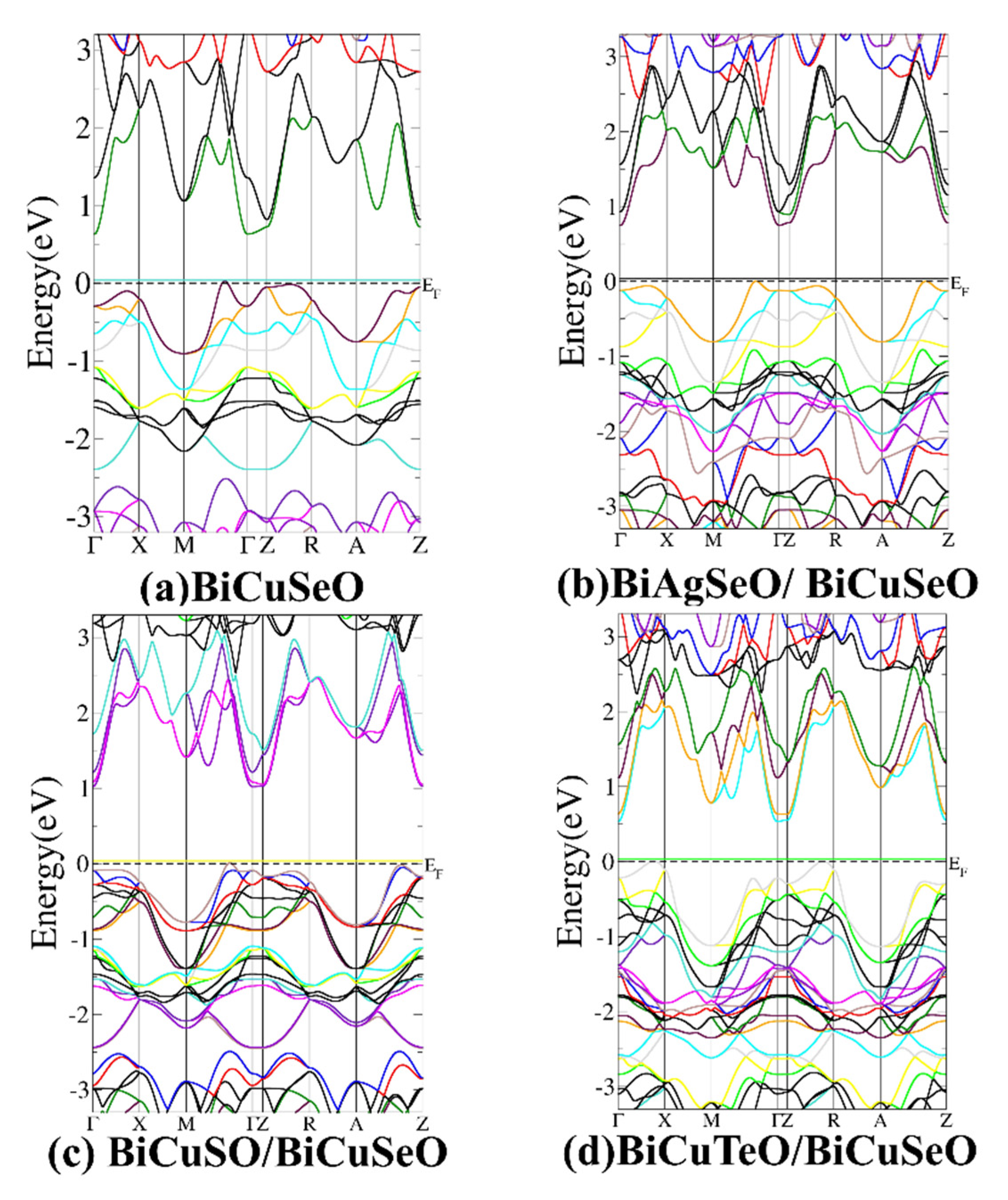
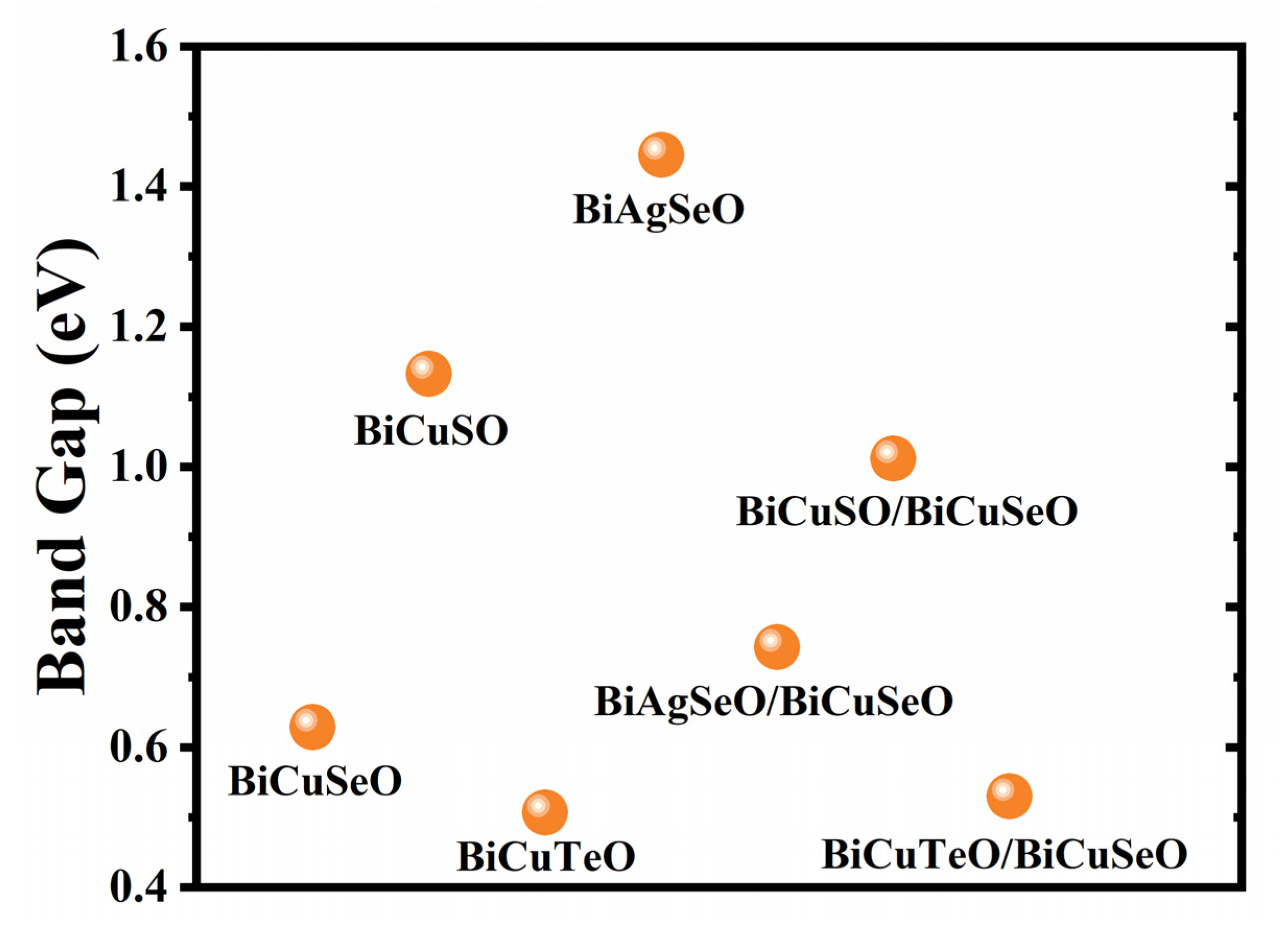
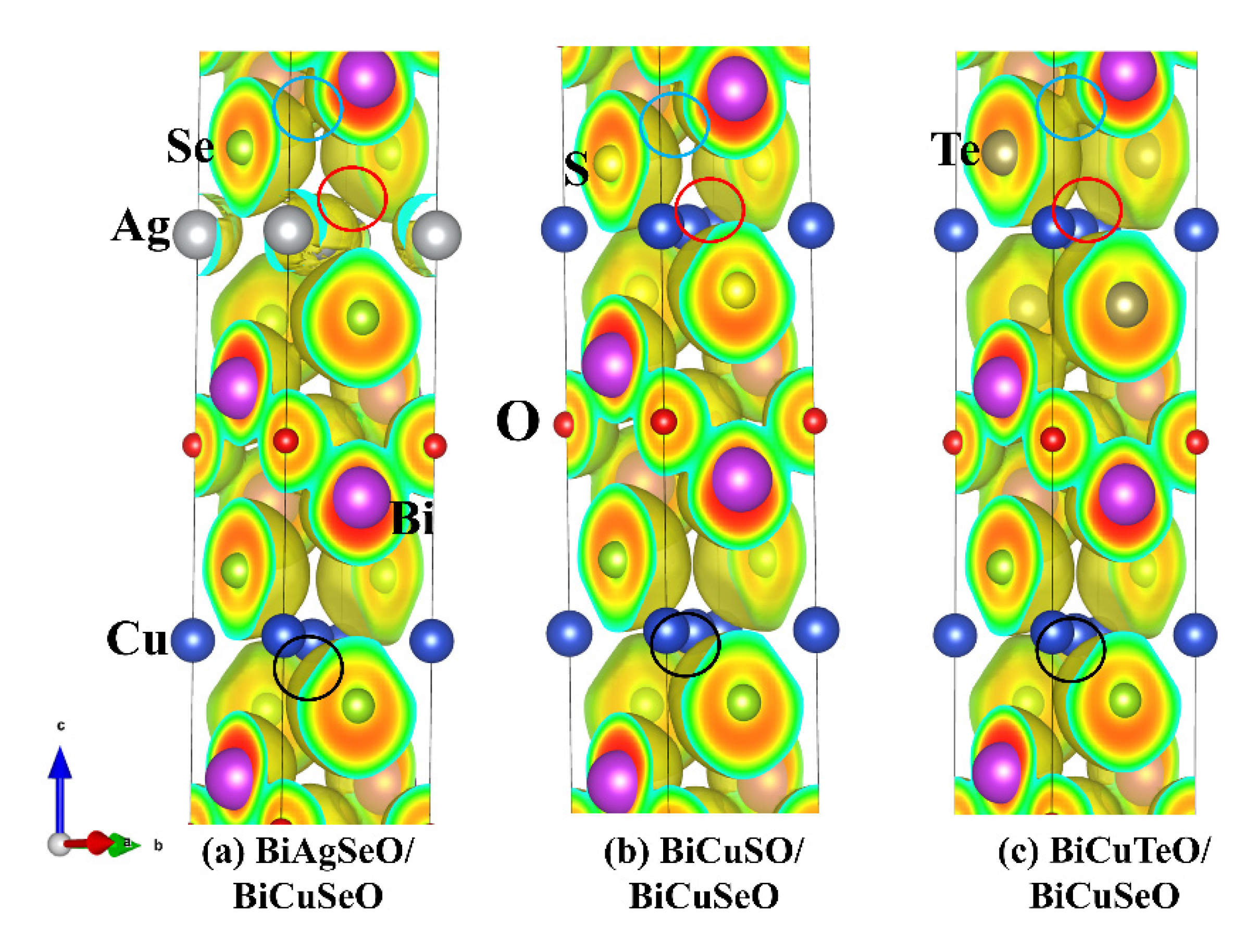

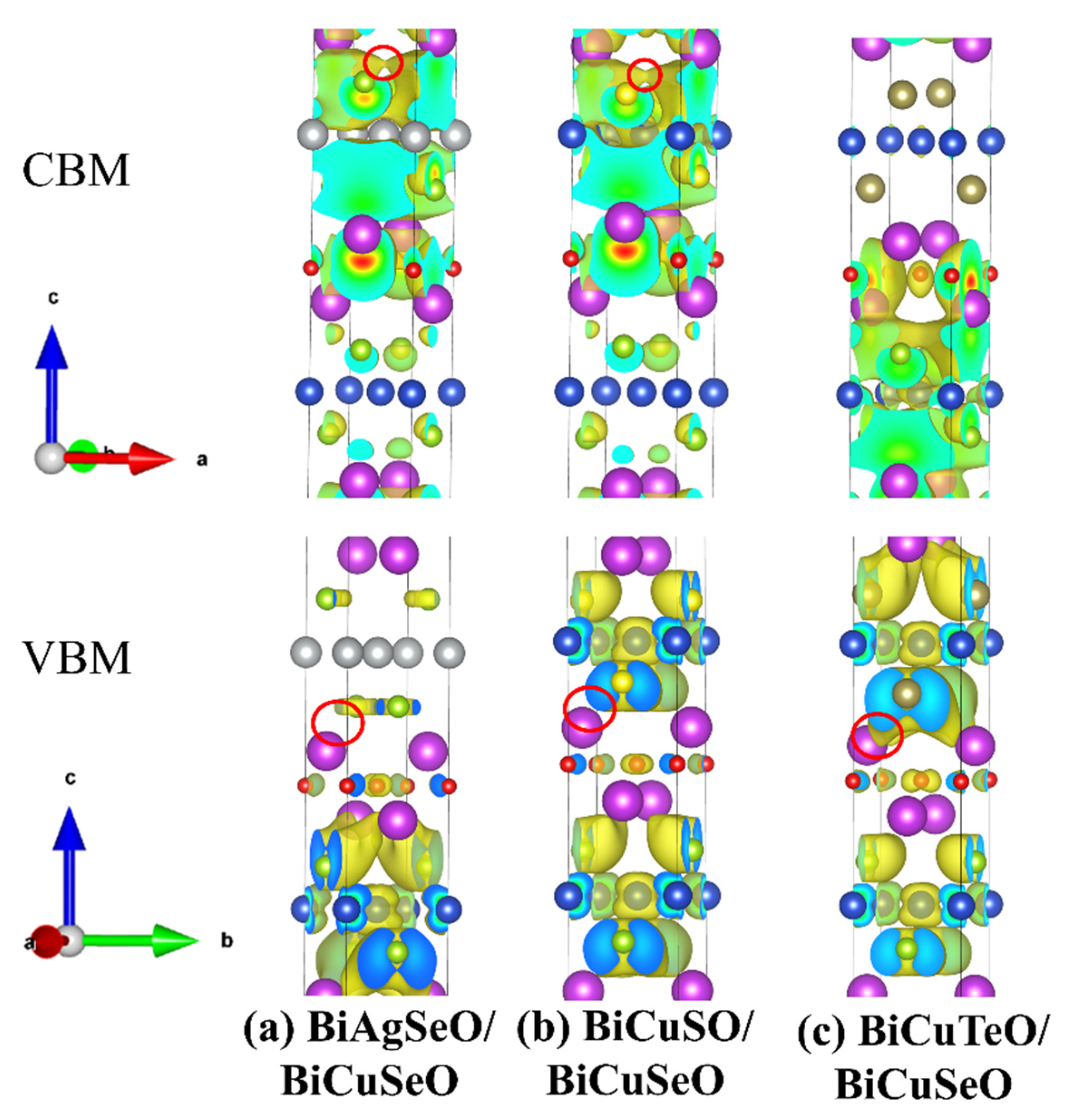
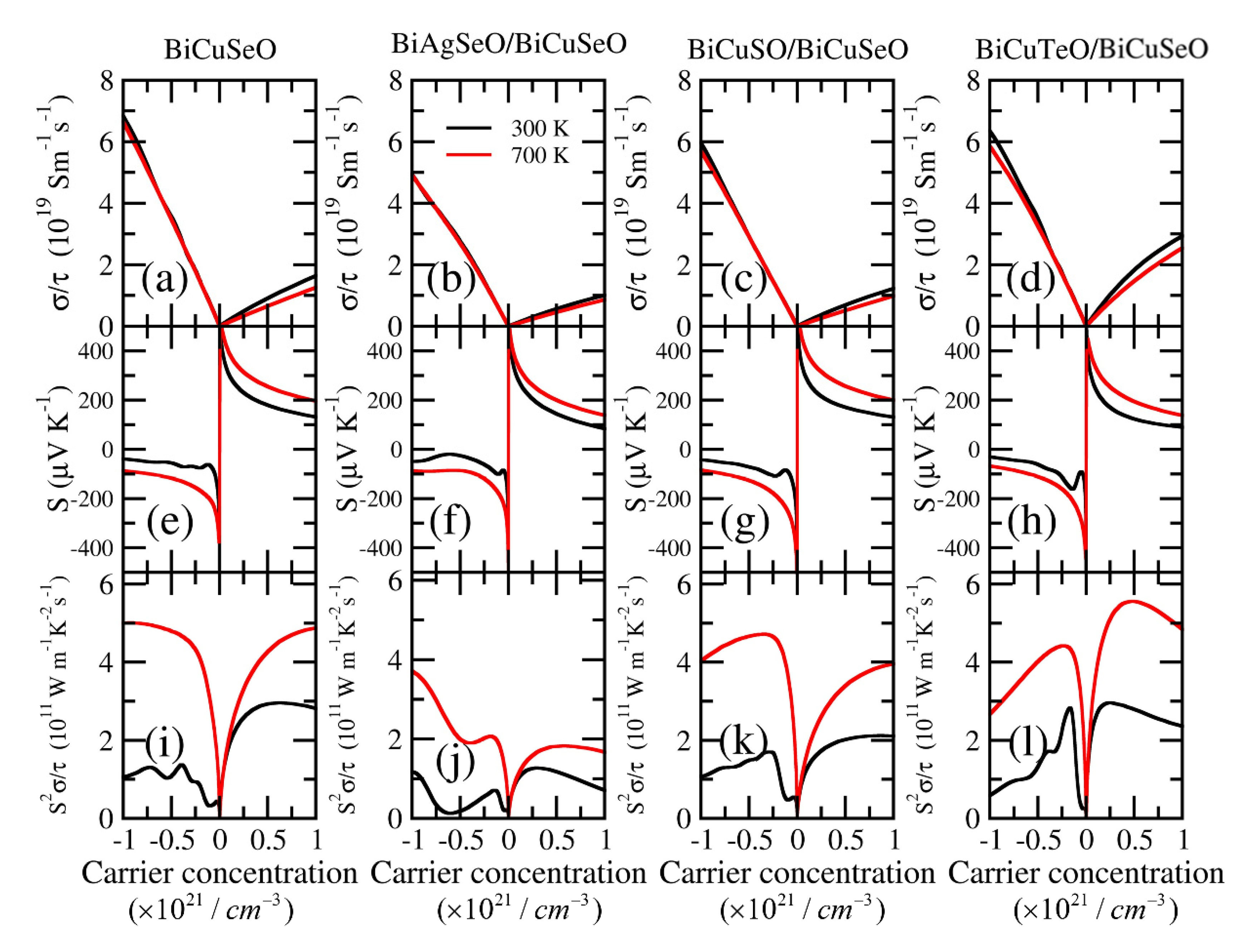

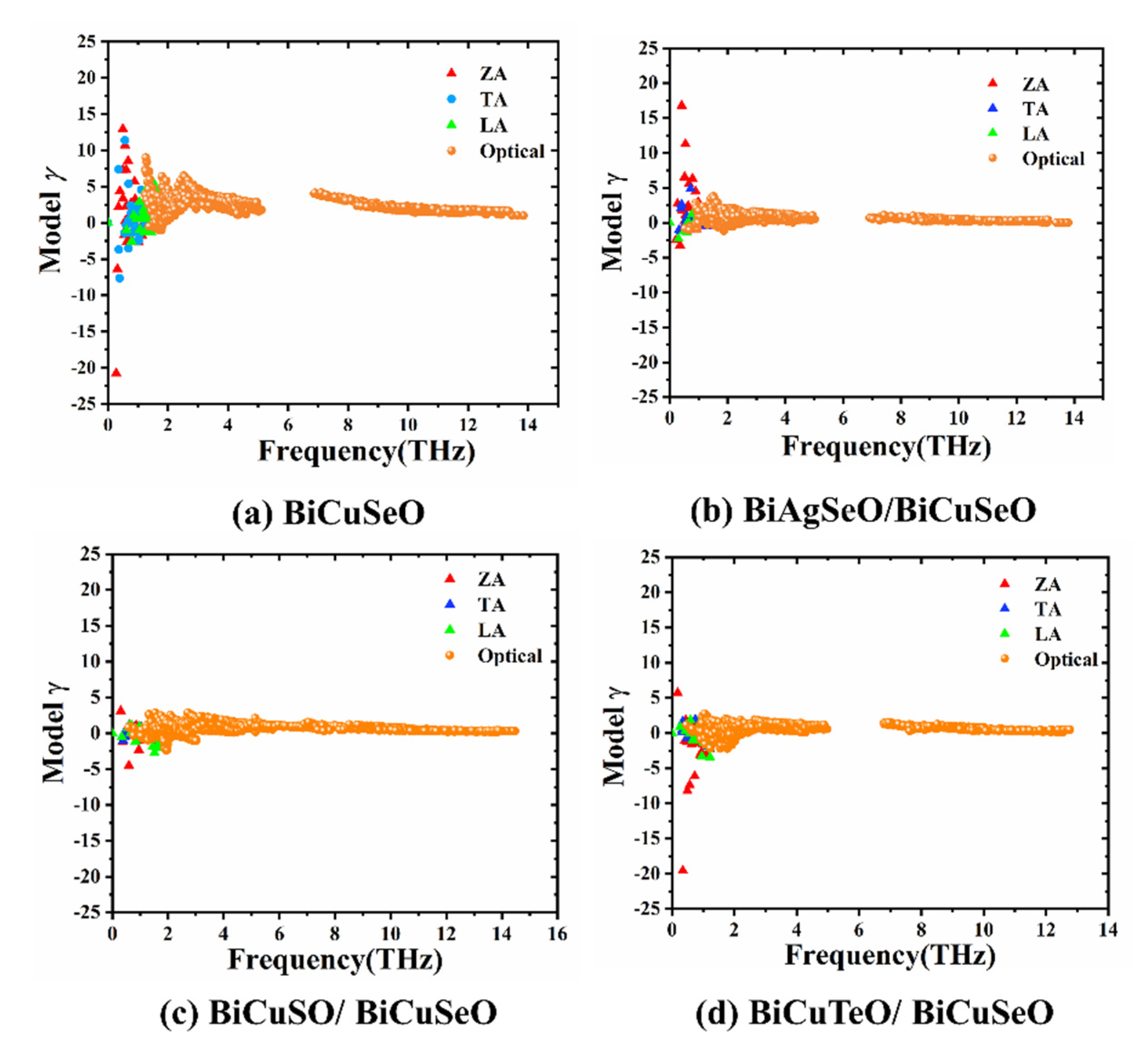
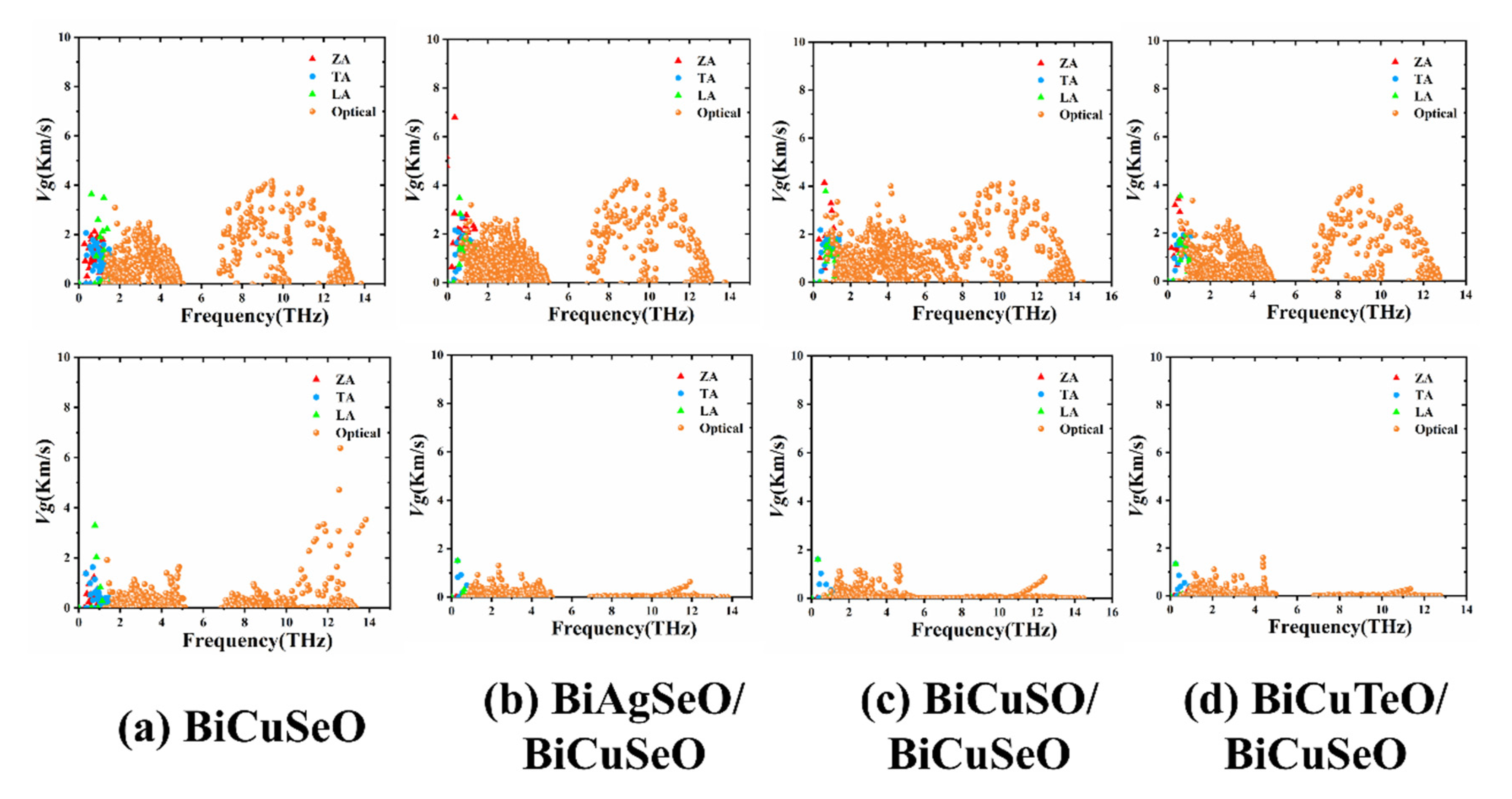
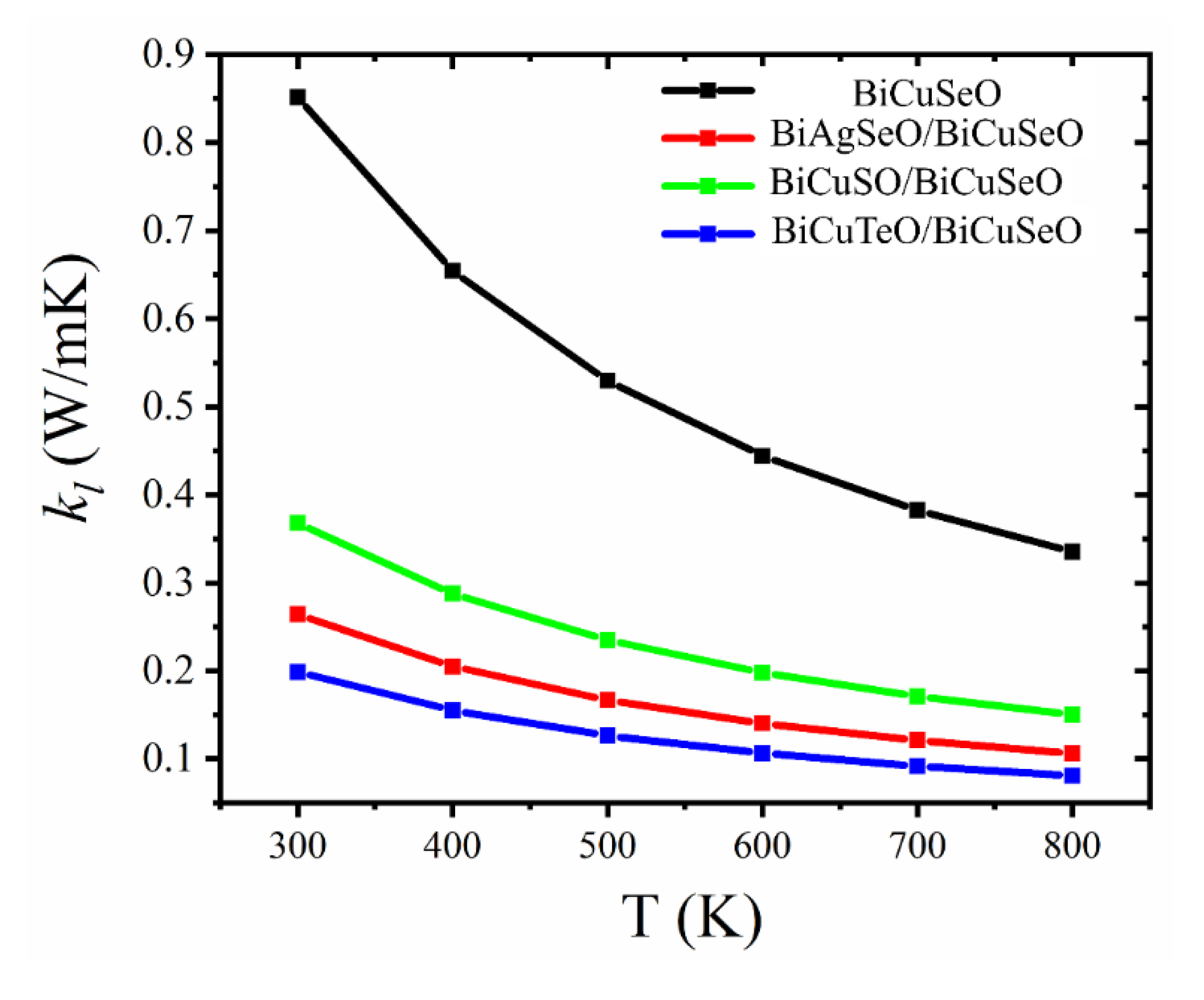
| a-, b-axis (Å) | c-axis (Å) | Band Gap (eV) | |
|---|---|---|---|
| BiCuSeO | 3.95 | 9.09 | 0.63 |
| BiCuSeO(expt) [12] | 3.92 | 8.91 | 0.8 |
| BASO/BCSO | 3.99 | 18.59 | 0.74 |
| BCSO/BCSO | 3.91 | 17.75 | 1.01 |
| BCTO/BCSO | 4.00 | 18.70 | 0.53 |
Disclaimer/Publisher’s Note: The statements, opinions and data contained in all publications are solely those of the individual author(s) and contributor(s) and not of MDPI and/or the editor(s). MDPI and/or the editor(s) disclaim responsibility for any injury to people or property resulting from any ideas, methods, instructions or products referred to in the content. |
© 2023 by the authors. Licensee MDPI, Basel, Switzerland. This article is an open access article distributed under the terms and conditions of the Creative Commons Attribution (CC BY) license (https://creativecommons.org/licenses/by/4.0/).
Share and Cite
Yang, X.; Sun, Z.; Ge, G.; Yang, J. Enhanced Power Factor and Ultralow Lattice Thermal Conductivity Induced High Thermoelectric Performance of BiCuTeO/BiCuSeO Superlattice. Materials 2023, 16, 4318. https://doi.org/10.3390/ma16124318
Yang X, Sun Z, Ge G, Yang J. Enhanced Power Factor and Ultralow Lattice Thermal Conductivity Induced High Thermoelectric Performance of BiCuTeO/BiCuSeO Superlattice. Materials. 2023; 16(12):4318. https://doi.org/10.3390/ma16124318
Chicago/Turabian StyleYang, Xuewen, Zhiqian Sun, Guixian Ge, and Jueming Yang. 2023. "Enhanced Power Factor and Ultralow Lattice Thermal Conductivity Induced High Thermoelectric Performance of BiCuTeO/BiCuSeO Superlattice" Materials 16, no. 12: 4318. https://doi.org/10.3390/ma16124318
APA StyleYang, X., Sun, Z., Ge, G., & Yang, J. (2023). Enhanced Power Factor and Ultralow Lattice Thermal Conductivity Induced High Thermoelectric Performance of BiCuTeO/BiCuSeO Superlattice. Materials, 16(12), 4318. https://doi.org/10.3390/ma16124318





